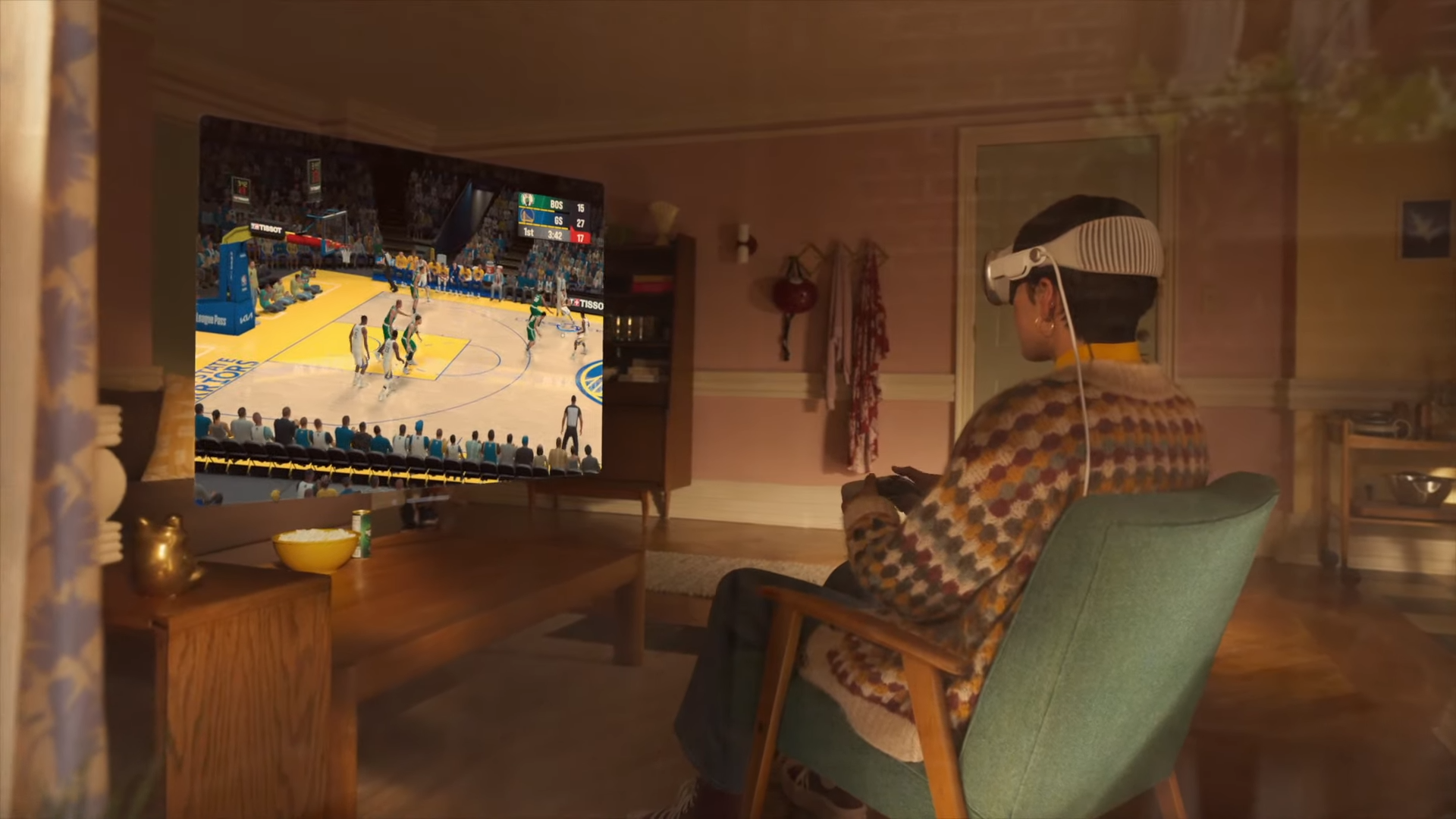Let me explain it. (Bear some time with me 🙂)
I didn’t even blink for a second the whole time the WWDC 2023 event was live.
(Just kidding 🤓)
Even then, I missed out on a few things that went under the radar, like that AirTag sharing update in iOS 17.
A few days later, I watched the Vision Pro film – again!
This time I focused much more on the details and the delivery.
Here’s one key moment from the (film/product launch) that I would like to share.
A man approaches his children in a dim, haze-colored room. They’re dipping wands into a dish of soap and blowing bubbles. The dad smiles and raises a finger to his brow, where a headset rests, bathing his eyes and capturing a live, lush, and breathable moment from the $3,500 aluminum-alloy ski goggles, covering his eyes behind two very small but high-resolution displays a very small distance in front of him. He taps a button to capture the video of his kids playing. He’ll be able to revisit and relive the memory later on the couch as if he’s right back in the exact moment. This forever-saved memory of his kids in a brilliant, unconstrained 3D screen will keep Dad smiling – always 🌟
Don’t stress out.
That was just Apple’s pitch.
So, What Exactly is Apple Vision Pro if it’s Neither AR nor VR
This is not a laptop, not a smartphone.
Neither a Virtual Reality nor Augmented Reality.
It’s a computer worn on your face.
In other words, the Vision Pro is a $3,499 headset.
A screen that you put on your face to interact with programs in 3-D space.
Rather than view the computer’s output through a physical screen, that output is projected directly into your eyes with two very high-resolution displays a very small distance in front of you.
Rather than control the computer through a keyboard, mouse, or touch screen, the primary
Rather than control the computer through a keyboard, mouse, or touch screen, you contact with digital objects through eye tracking and gestures.
The headset will fully enclose you in a virtual environment. You will also be able to look at and record the world around you.
The series of cameras built into the goggles pipe whatever is happening outside your body into a video feed in front of your eyes.
This sort of thing is usually called “mixed reality.”
So, what can we really do with a spatial computer?
Apple says that Vision Pro displays current 2D information on a much more flexible and unconstrained display.
Apple envisions Vision Pro to fit into places that do not have much space.
Usually, people pay for a very large-screen TV. They even pay $3,500 for that. Even Apple sells the Pro Display XDR for $6,000.
From that perspective, it is not extravagant if we think about it.
Think about it. It is a powerful machine for developers to create AR and VR apps that could end up defining what we expect from mixed reality in the future.
But, 2D content, does not appear to justify the technological and R&D development that has gone into the Vision Pro.
The real question is whether this device is augmented or virtual reality because we see that it straps on to your head.
Apple has barely mentioned the terms AR and VR during their announcement.
So, what is it?
The technology is a spatial computer.
If there is a role for AR and VR, it is in applications that run on a spatial computer.
Let’s understand AR.
Augmented reality integrates digital information on top of a user’s physical surroundings in real time.
In other words, it takes the environment around you and changes your perception of it.
Google Glass did this by showing you notifications via smart glasses.
The Vision Pro did the same but replaced the 2D displays in that environment and fixed them so that when your head moves, the display does not.
AR integrates digital information on top of a user’s physical surroundings in real time.
It is achieved by passing a very accurate video of the real world through the device to you.
It seems like you don’t see your environment directly, but you think you are doing so.
Thus, technically, Apple is augmenting a video capture of your environment, not overlaying things on your direct viewing of it. So, in reality there is no difference.
Virtual Reality or VR takes the user and immerses them in a virtual environment.
The Vision Pro captures the full attention of your eye.
This means that you are immersed in a virtual environment.
All you do is turn the dial, and you’ll be transported somewhere else.
The video-pass through from your current environment is replaced by a digitally created 3D environment. From that perspective, Vision Pro is clearly a VR device.
As it turns out, AR and VR both work in accordance with each other.
VR has the ability to present the user with more relevant information, and AR immerses users in new contexts by bringing that information to them.
AR takes information in a given context and parses it to yield the information that is relevant.
The one thing to note is that the Vision Pro is not meant to be used outside in environments such as while driving. This limits its applicability in navigating external elements.
Think about it in this way.
You design and prototype new aircraft or building, or assist in remote medical procedures.
The Vision Pro exhibits capabilities of being able to do such things.
Vision Pro is an unconstrained 3D screen. This device is seen as a powerful machine that enables developers to innovate a whole new spectrum of apps.



